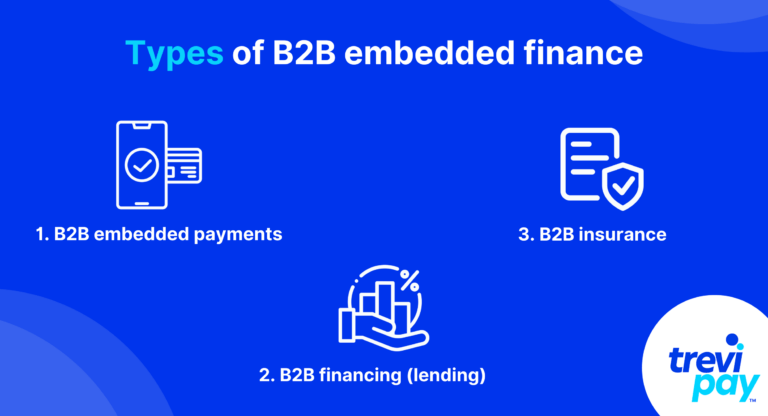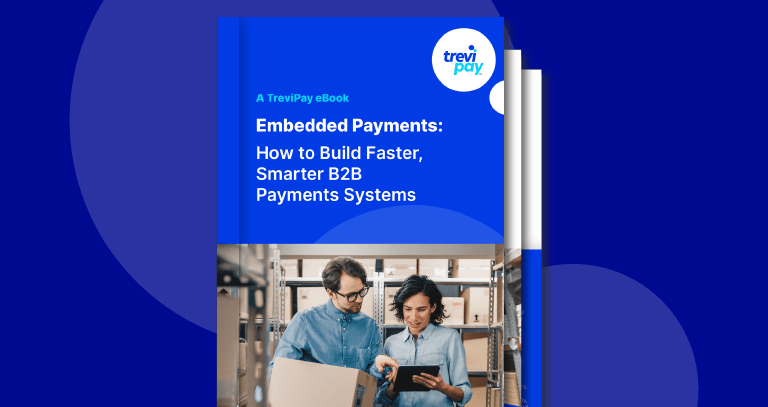Delivering financing services to business-to-business (B2B) customers can make a big difference to a company’s growth.
Delivering them seamlessly and in the context they are needed can make an even bigger difference.
This is why, in the world of B2B eCommerce, embedded finance is not just a value-added service for most companies. It is also a necessity…
Let’s look closer at embedded financial services in the B2B market.
What is embedded finance?
Embedded finance refers to the integration (embedding) of various financial products and services into non-financial service companies’ processes via APIs (application programming interfaces).
These financial services include banking services (like access to current accounts), lending, insurance, investing, and more.
They conveniently enable businesses to provide customers with different ways to fund their purchases. And they provide them at the crucial time – at checkout – which can significantly reduce cart abandonment for businesses.
Third-party alternative lenders often work with traditional financial institutions to provide these services. And payment orchestration platforms that specialize in the end-to-end integration and management of payment systems can help achieve this.
Embedded payments
Embedded payments are integrated on and offline payment systems that allow customers to seamlessly initiate transactions in-store, on websites or on apps.
They are technically a type of embedded finance – and the most popular type, too. However, they are often discussed separately from other forms of embedded finance options and solutions.
This is because they are relatively straightforward and widely recognized. They are suitable for just about every business. Other financial services are more industry and company-specific.
Why embedded finance matters for business-to-business (B2B)
Business-to-consumer (B2C) commerce adopted embedded finance services and solutions early on.
Initially, this trend was not as popular in the B2B world. After all, there have long been significant differences between B2C and B2B business process cultures.
But B2B customers are also B2C customers. They increasingly bring their expectations from the former to the latter world.
This does not mean that embedded B2C solutions can be applied to B2C directly. The optimal solution is to find tailored financial products and services for companies’ specific needs.
Similarities between B2C and B2B embedded finance
Like B2C customers, most B2B ones expect convenience, multiple payment and financing options, and more.
For example, a payments study TreviPay commissioned found that over 90% of surveyed global decision-makers expect giving B2B customers better payment options will:
- Improve customer satisfaction
- Speed up transactions
- Free up internal resources
- Increase business success
And as the B2C embedded finance market changes, so too does the B2B one. The latter simultaneously learns from the former whilst developing solutions specific to the embedded finance journey of its users.
Differences between B2B and B2C embedded finance
B2B embedded finance solutions often need to accommodate the specific industry, size, or business model of their users. They are also likely to take on risk with customers who require larger amounts of credit.
By contrast, B2C solutions are typically much more likely to be one-size-fits all models. B2C vendors can similar amounts of products and services to most clients. Having a larger number of customers makes them less prone to the effects of individual clients defaulting.
Types of B2B embedded finance

1. B2B embedded payments
B2B payment integration is essential for both on and offline channels.
One-click (or card swipe) payments at checkout significantly contribute to a frictionless B2B buyer’s journey. This in turn increases conversion rates and customer loyalty.
B2B transactions involve different methods to B2C ones. And unlike B2C payments, companies need to consider issues such as invoice processing and net credit terms.
2. B2B financing (lending)

Trade credit
Trade credit is the most popular and widely used for of B2B financing. It allows customers access to products and services from vendors before making payments for them.
Suppliers’ approval conditions and payment schedules vary according to industry and customers. However, net 30-, 60-, or 90-day terms, are common.
Unlike standard bank loans, trade credit doesn’t always involve an intermediary. But there are third-party specialists with advanced technology and knowledge that provide white-label services.
Credit lines
Credit lines in business are flexible loans for borrowing credit up to a pre-agreed limit. They provide a source of funds that’s quickly available and is there for useful for helping manage cash flow or covering unexpected costs.
Unlike trade credit, credit lines are not tied to specific transactions or goods.
Invoice financing
Invoice financing refers to the selling or borrowing against outstanding invoices to gain access to credit. Third-party invoice financing companies enable this by providing capital upfront.
Invoice financing comes in two main forms:
- Invoice discounting: Businesses using unpaid invoices as security or a type or desposit for obtaining loans. It provides them with quick access to most of the value of an invoice.
- Invoice factoring: Businesses sell outstanding invoices to third-party providers (factors). The factor pays the business most of the invoice’s value upfront (minus their service fees), then collects the invoice directly from the business’s customer at the agreed payment date.
There are several differences between these two kinds of invoice financing, including fee structure, the amount of invoice made available, collections, and more. And each one comes in.
Buy now pay later (BNPL)
BNPL in a B2B context is the same underlying concept driven by different principles to its B2C version.
To put it another way, the basic system is the same: businesses buy things now, and pay them back later in interest-free installments. They also share the same core technology fundamentals, such as point of sale (POS) systems and online gateways,
However, they differ in purpose, process, and payment terms. For example, it’s often necessary to provide longer payment terms in B2B payments and involve more decision-makers and diverse payment methods.
3. B2B insurance
B2B transactions often carry risk because of the large payments involved and the consequences of losses. And the potential for losses is often high because of factors such as:
- Long and complex logistics and supply chains
- Regulatory requirements and changes
- Customized products or services (i.e., products with higher chances of not meeting customers’ expectations)
This makes specialized insurance offering a necessary precaution for many B2B suppliers and customers.
TreviPay’s B2B embedded finance solutions
TreviPay’s B2B payments platform emphasizes scalability. It allows business buyers to select invoicing at checkout across multiple sales channels.
It also simplifies the order-to-cash process for B2B customers by integrating purchase controls and offering trade credit and net terms – features which can increase average order value (AOV) and customer lifetime value (LTV).
Our platform’s integration with APIs for eCommerce, accounting software, and other payment providers and gateways is seamless. It supports frictionless purchasing capabilities and consistent branding for all business sizes, as well as customizable payment methods and communication channels.
Conclusion
The growing popularity of embedded finance solutions in B2B commerce is transforming how businesses manage financial transactions.
It is driven by expectations from customers for convenience and efficiency, brought over from the B2C domain, and innovation by businesses.
B2B embedded finance requires a more nuanced approach than the B2C version. It needs to be tailored to meet the specific needs of businesses. This applies to all aspects of it, including:
- Seamless payment solutions
- Flexible financing options like trade credit and invoice financing
- Specialized business insurance products
Companies that adopt these solutions can simplify their own processes and enhance customer satisfaction and loyalty.
This shift is crucial for businesses looking to stay competitive as increasing digitization and new software platforms proliferate.
As this trend continues to develop, it will undoubtedly unlock new opportunities for growth, efficiency, and innovation in the B2B sector. This in turn will solidify embedded finance as a key component in the future of business transactions.






